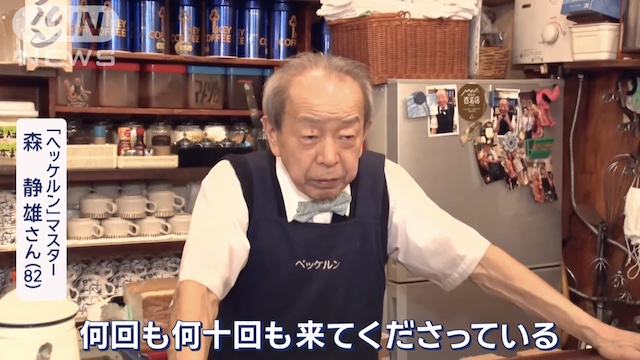TOKYO, May 19 (News On Japan) - In Tokyo's Minato Ward, 'Heckeln,' a cafe founded in 1971, sees more than 50 foreigners lining up daily before it opens. Their target is the 'Special Jumbo Pudding,' priced at 500 yen. It is about 2.5 times the size of a typical pudding.

The 82-year-old master's performance of removing the pudding from the mold without using a spatula is also popular. Among the regular customers was Sayuri Yoshinaga.
'Sabouru,' located in Jimbocho, was founded in 1955. Foreign customers flock here for the Japanese-born Western dish 'Napolitan,' priced at 900 yen. The Showa retro interior is also a reason for its popularity. The cafe was loved by literary giants such as Shusaku Endo.
Foreigners Flock to Famous 'Special Jumbo Pudding'
More than 50 foreigners line up daily before opening at the long-established cafe 'Heckeln,' founded in 1971.
A visitor from America: 'I want to experience Japanese culture and food.'
A visitor from Saudi Arabia: 'It feels comfortable.' 'The interior design is wonderfully old-fashioned.'
A visitor from Canada: 'The old look gives me a sense of Japan.'
Foreigners are attracted to the Showa retro atmosphere. The cafe features a dessert that has garnered international attention: the 'Special Jumbo Pudding,' priced at 500 yen. Many visitors come from overseas just to taste this specialty.
A visitor from Canada: 'Amazing! It's my first time experiencing this.'
The famous pudding, highly praised by foreigners, has been maintained for over half a century by the master's dedication.
The pudding is about 2.5 times the size of a typical one. It is a slightly firm, handmade pudding made in the Showa style, with a maximum of 60 pieces produced per day. It usually sells out by noon.
A visitor from Taiwan: 'It's very soft.'
A visitor from Saudi Arabia: 'Wonderful. Delicious.'
The rare pudding, acclaimed by foreigners, has a unique taste.
Announcer Sayaka Masuda: 'Delicious. The gentle sweetness of the eggs spreads in your mouth. The caramel is neither too sweet nor too bitter. It perfectly enhances the flavor of the eggs.'
A visitor from Saudi Arabia: 'It was creamy, sweet, and very delicious. It was different from Saudi Arabian pudding. It was like cheesecake. It was worth the wait.'
The charm of the cafe is not only in the taste. Many foreigners focus their cameras on the 82-year-old master, Shizuo Mori, who has been making the pudding since the cafe's founding.
To prevent the pudding from collapsing when removed from the mold, the master uses centrifugal force. His unique performance has been a staple since the cafe's inception.
Mori: '(Q. How many did you prepare?) Today, about 60. It's tough to make more than that. But I don't make extra in advance.'
'(Q. What time do you start preparing?) Around 5:20 AM.'
'(Q. Every morning?) Yes.'
'(Q. Isn't it tough?) If you think it's tough, everything becomes tough.'
Sayuri Yoshinaga, a Regular for Over 30 Years
Among the loyal customers attracted by the unwavering taste is Sayuri Yoshinaga, who has been visiting for over 30 years.
Mori: 'Sayuri Yoshinaga. She has come many times, countless times. She even gave me this cutting board.'
'(Q. The cutting board you're using now?) Yes.'
The cutting board, gifted by Yoshinaga about two years ago, is a treasured possession of the master.
So, why have many foreigners been visiting 'Heckeln' in recent years?
A visitor from Taiwan: '(Q. How did you know about this place?) I saw a video on Instagram by someone from Taiwan showing a delicious-looking pudding. From then on, I wanted to try it when I had the chance.'
A visitor from Austria: '(Q. Why did you come here?) I saw it on Instagram.'
The video of the jumbo pudding posted on social media spread worldwide, leading to an influx of foreign visitors.
The Showa retro cafe, loved by long-time patrons and new foreign customers, continues to thrive in the Reiwa era.
Secret Napolitan... One Master's Fascination
The Showa retro cafe 'Sabouru' in Tokyo's Jimbocho is also popular among foreigners. The cafe, with its unique atmosphere that seems frozen in the Showa era, attracts many visitors. Foreigners come here for the traditional cream sodas in melon, blue Hawaii, strawberry, lemon, orange, grape, and Calpis flavors.
And one more thing...
A visitor from South Korea: 'I heard the Napolitan here is famous and wanted to try it.'
The Japanese-born Western dish 'Napolitan,' priced at 900 yen, is another draw. 'Sabouru's Napolitan is a hearty dish with bacon, Bologna sausage, mushrooms, onions, and green peppers.
A visitor from South Korea: 'It's delicious. Really tasty. Napolitan in Korea is a bit spicy, but Japanese Napolitan is not spicy, slightly sweet, and can be enjoyed by everyone.'
Announcer Masuda: 'The balance of the tomato sauce's acidity and sweetness is exquisite. It's the nostalgic, rich "Napolitan."'
Masashi Ito, the fourth-generation master, was captivated by this Napolitan about 20 years ago.
Ito: 'When I first tasted Napolitan, it was so delicious that I thought, "I want to work here." I was looking for a part-time job at the time, during my university days.'
'(Q. Were you impressed by the Napolitan?) Yes, I was. It was so delicious that I wanted to learn how to make it. I had an interview on the spot.'
His enthusiasm was recognized, and he was hired immediately, but there was an unexpected twist.
Ito: 'I was not assigned to the kitchen. I was told I could work as a hall staff. So I started working from there, but I've been in the hall ever since. I still can't make Napolitan.'
The secret recipe for Napolitan is only known to the experienced kitchen staff. Another signature dish is ginger pork.
A visitor from Portugal: 'There is a similar dish in Portugal, but it's not as sweet.'
The man referred to 'Bifana,' a Portuguese dish similar to Japanese ginger pork, but with a slightly spicy taste from paprika, garlic, and chili. On the other hand, the cafe's ginger pork uses slightly thick slices of domestic pork, stir-fried in soy sauce-based sauce with plenty of onions to enhance its sweetness.
A visitor from Portugal: 'Nice. The pork is delicious.'
João, a visitor in his 70s, was so impressed by the ginger pork at the historical cafe that he sent a video of a Portuguese dish made with pork back home. It's a local dish where pork is stir-fried in clam soup.
Expanding Popularity... Experiencing the Flavors Loved by Japanese Authors
Why are Showa retro cafes now loved by foreign tourists?
A visitor from the Philippines: 'It's cute. Unlike the usual cafes, I was attracted to the old-fashioned atmosphere.'
A visitor from South Korea: 'Koreans love Japanese historical things. We love Japanese sensibility.'
While the cafe's popularity started from social media, some visitors have other reasons for coming.
A visitor from the UK: 'I came after seeing an interview with Sayaka Murata. She said she likes to write at "Sabouru."'
'Sabouru,' frequented by Akutagawa Prize-winning author Sayaka Murata, and other writers such as Shusaku Endo and Go Osaka, is now visited by foreigners who want to experience the flavors loved by famous Japanese authors. The Showa retro cafe boom continues to expand.
Source: ANN















